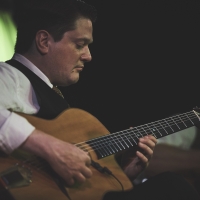DjangoBooks.com
Welcome to our Community!
Categories
- 20K All Categories
- 1.1K General
- 477 Welcome
- 59 Archtop Eddy's Corner
- 146 CD, DVD, and Concert Reviews
- 385 FAQ
- 26 Gypsy Jazz Italia
- 27 Photos
- 202 Gypsy Picking
- 21 Unaccompanied Django
- 15 Pearl Django Play-Along Vol.1
- 17 Gypsy Fire
- 45 Gypsy Rhythm
- 1.4K Gypsy Jazz University - Get Educated
- 131 Gypsy Jazz 101
- 227 Repertoire
- 219 History
- 708 Technique
- 51 Licks and Patterns
- 6 Daniel Givone Manouche Guitare Method Users Group
- 20 Eddie Lang Club
- 1.3K Gypsy Jazz Gear
- 802 Guitars, Strings, Picks, Amps, Pickups and Other Accessories
- 460 Classifieds
- 49 Recording
- 62 Other Instruments
- 18 Violin
- 5 Mandolin
- 22 Accordion
- 7 Bass
- 10 Woodwinds
- 348 Gypsy Jazz Events
- 143 North America
- 110 Europe
- 95 International
In this Discussion
Which variety of dominant scale should I use?
 djangology
Portland, OregonModerator
djangology
Portland, OregonModerator
Which variety of dominant arpeggio would be the best to start with for the genre of gypsy jazz?
1. Dominant 7b9 (based on diminished h/w scale)
2. Dominant 9th (based on the Mixolydian mode)
3. Dominant 7b5b9 (based on the Super Locrian scale from the melodic minor scale)
My personal guess is #1 , but am I wrong? Of course, I realize that all of these are "possible" or "correct" to use in gypsy jazz but I am asking which one does your ear say is the most common sound?
I want to spend a week studying this arp really hard and I don't want to shoot off in the wrong direction from the start. I suppose that maybe I am answering my own question by looking at Wrembels book and it seems he is always using the dom7b9. Thanks for your vote and your help. :-)
1. Dominant 7b9 (based on diminished h/w scale)
2. Dominant 9th (based on the Mixolydian mode)
3. Dominant 7b5b9 (based on the Super Locrian scale from the melodic minor scale)
My personal guess is #1 , but am I wrong? Of course, I realize that all of these are "possible" or "correct" to use in gypsy jazz but I am asking which one does your ear say is the most common sound?
I want to spend a week studying this arp really hard and I don't want to shoot off in the wrong direction from the start. I suppose that maybe I am answering my own question by looking at Wrembels book and it seems he is always using the dom7b9. Thanks for your vote and your help. :-)























Comments
Good question...however, it all really depends on what sort of dominant chord you are talking about. Just a dominant with no tensions? what about 9, b9, #9, 13, etc...
Much of the time that is going to dictate your choice of arp more then anything else.
Also, in what context is this hypothetical dominant chord? Does it resolve to a minor, major, or is part of a cycle of dominants?
My point is that, even if we could say that Gypsies play a dominant 9 arp 99% of the time, that doesn't help you if the rhythm section is playing a dominant 7 (b9, b13). It won't sound too good....
-Michael
1. G13b9
2. G7#5
3. A7b9
4. G7b5
I´m still a beginner and has not that much experience in this, but when it´s a G13b9 than you can play the 13th and the 9th or not. It is still dominat 7. But see that you don´t use the #9th or 9th.
Works for the other chords, too.
That´s how would think about it, but if I´m wrong please correct me!!!
(Or am I just repeating what Michael said?)
1. G13b9
the most obvious choice is the octatonic scale. Some call this a half-step-whole-step scale, or you could think of it as an inverted diminished scale.
Whatever you call it, here are the notes.
G Ab Bb B C# D E F
Note that this one also gives you the flat five. The Ab diminished arpeggio on which this scale is based is nice, though you don't get the 13.
Ab Cb Ebb (D) F
You could also try this one:
G Ab B C D E F
I don't have a name for this one, but it is derived from one of the Persian modes. You could call it mixolydian b2 I guess.
It works very well.
The second mode of the jazz melodic minor scale is also a possible option, but you miss out the major third and add a #9 as well as the b9
F G Ab Bb C D E
2. G7#5
There are oodles of scales for this one:
best are:
Whole tone: G A B C# D# F
Super-locrian or altered: G Ab Bb B C# D# F
Ab min 6 pentatonic: Ab Cb (B) C# D# F
also possible are:
Mixolydian b6 (5th mode of jazz melodic minor): G A B C D Eb F - note that you get both the regular and raised fifth (lowered 6) here.
5th mode harmonic minor or mixolydian b2b6 or spanish phrygian:
G Ab B C D Eb F - note that you get both the regular and raised fifth (lowered 6) here.
3. A7b9 - see above scales with flat 9 in them.
4. G7b5
Lydian dominant: G A B C# D E F
Whole tone: G A B C# D#
E minor 6 pentatonic: E G A B C#
Have fun.
Jared
[/b]
Kerouac - most of the time the chord symbol is a shorthand and implies other alterations which match up with the corresponding scale, so you CAN play #9 on a 13b9 (see below)
G13b9 on a chord sheet is the same as G7b9. A chord symbol with natural 13 and b9 implies the half/whole diminished scale, so spelling out the chord in full would actually look like:
G7 b9 #9 #11
but to save space G7b9 is generally used.
G7#5: although the altered scale has a #5 in it, if you want to imply the altered scale you write G7alt. So calling a chord G7#5 shows the improviser that the chord is derived from the whole tone scale. The full chord symbol would be G7 #11 #5. To save space the symbol G7#5 is used.
A7b9 - same as G13b9
G7b5 or G7#11 implies the lydian dominant scale - although the whole tone scale has a #11 too and can be used over this chord, the chord symbol G7#11 tells you that the chord is derived from the lydian dominant scale.